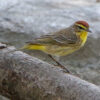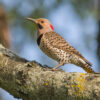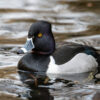Red-headed Woodpecker, Melanerpes erythrocephalus
Bill Rowe
The stunningly handsome Red-headed Woodpecker has been a favorite American bird for as long as anyone has kept written records, and no doubt for millennia among indigenous peoples. It is very much a bird of the eastern and central United States; its range extends only a short distance into Canada, with a western limit along the edge of the Great Plains from New Mexico to Montana, and it has never been recorded south of the border. Red-heads that nest in the colder parts of this range—e.g., the upper Plains, Minnesota, parts of the northeast—routinely migrate south in the fall, typically flying low by day, so that they can be watched and counted by birders at rates averaging up to 100+ birds/hour. Where they stop to spend the winter may be governed by the food they can find, with the largest wintering populations occurring in oak woods where the acorn crop is heaviest. Here in Missouri, the numbers recorded on Christmas Bird Counts are sometimes among the highest in the nation, occasionally reaching the mid-hundreds on a single count (inside a 15-mile diameter circle). That said, Red-heads have always been subject to drastic gains and losses, and the overall picture in recent years is one of decline; the records on Breeding Bird Surveys suggest that the current total population may be less than half what it was fifty years ago. This may have partly to do with the availability of nest sites, since Red-heads prefer dead tree limbs and snags in semi-open forest. In some areas they may have had serious competition from European Starlings, although that is not totally proven.
IDENTIFICATION: Absolutely unmistakeable! Even with an imperfect view, or in flight, the big white wing patches will always identify a Red-head, including a juvenile whose head is still brown (and whose wing patches will be crossed by a couple of dark bars). And as with all woodpeckers, the vocalizations will give it away too: listen for a shrill queeah or a short dry rattle.
ST. LOUIS STATUS: More local and less ubiquitous than, say, the Red-bellied Woodpecker, but still a common bird in many wooded areas, including those that are relatively open and park-like. In urban areas, not usually found in dense residential settings but often in larger parks or on golf courses. Numbers may go up and down by season, and the migration described above can often be seen in September and October.
Learn more and listen to the calls of Red-headed Woodpeckers here.


Juvenile
Photo Credit: Al Smith
In Flight
Photo Credit: © Joshua Vandermeulen
Ontario, May 9, 2015; Cornell Lab of Ornithology, All About Birds




